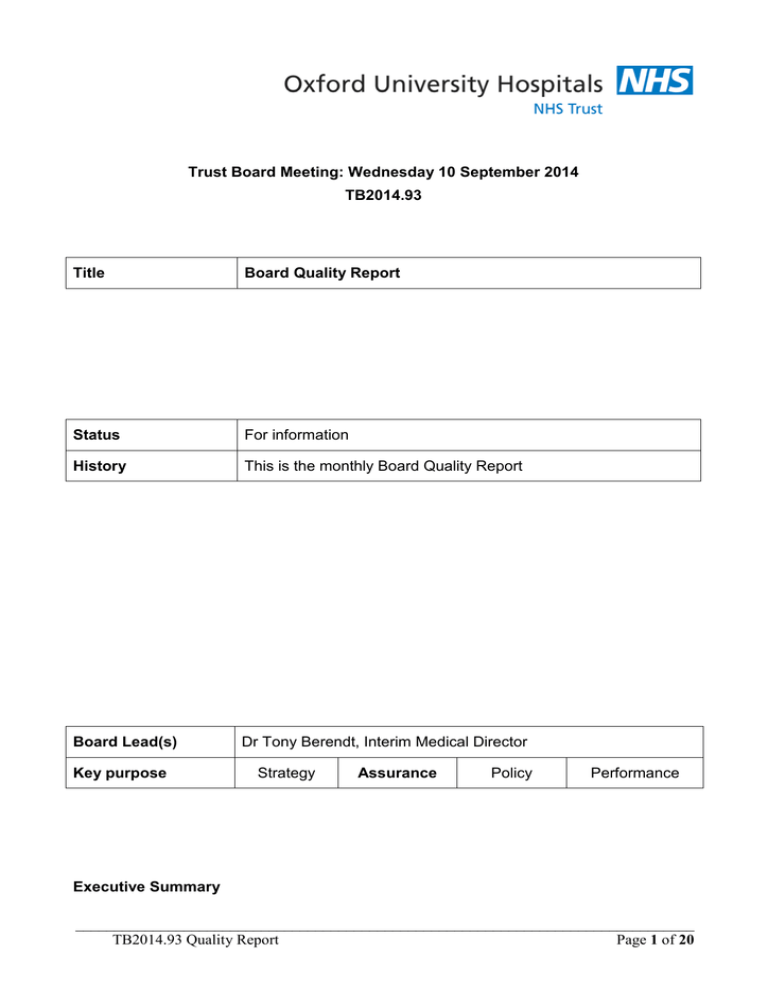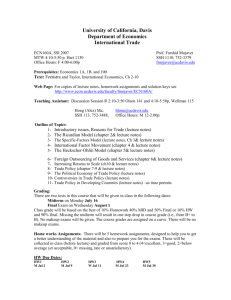For information This is the monthly Board Quality Report
advertisement

Trust Board Meeting: Wednesday 10 September 2014 TB2014.93 Title Board Quality Report Status For information History This is the monthly Board Quality Report Board Lead(s) Dr Tony Berendt, Interim Medical Director Key purpose Strategy Assurance Policy Performance Executive Summary ________________________________________________________________________________ TB2014.93 Quality Report Page 1 of 20 Oxford University Hospitals TB2014.93 1. The Board Quality Report (BQR) presents information that is as contemporary as possible. Where possible this if validated information, but unvalidated information is sometimes included if more contemporaneous. 2. In relation to key quality metrics: • For 17 of the 54 quality metrics, pre-specified targets were not fully achieved in the last relevant data period. For selected metrics, trend data are provided along with brief exception reports. • 7 of the key quality metrics are reporting with the most contemporaneous data available. • The remaining data will be entered throughout the month following validation by the indicator owners. 3. In relation to patient safety and clinical risk: • 6 Serious Incidents Requiring Investigation (SIRI) were reported in August 2014. 4. In relation to Quality Walk Rounds: • There were 4 Quality Walk Rounds in August 2014. 5. In relation to clinical effectiveness: • The next Summary Hospital-Level Mortality Indicator (SHMI) update is due to be published in October 2014. 6. In relation to CQUIN / Quality Priorities: • Divisional reporting against quality priorities occurred in August 2014 via the Clinical Governance Committee. • Quarter 1 achievements for the three National CQUINs (Dementia, Friends and Family Test, and Pressure Ulcer Prevention) are provided 7. Patient Experience: • Patient experience information is presented in dashboard format; this includes Friends and Family Test data, complaints, activity, PALS contacts and compliments. Recommendation The Trust Board is asked to receive this report. TB2014.93 Quality Report Page 2 of 20 Oxford University Hospitals TB2014.93 Board Quality Report 1. Purpose 1.1. This paper aims to provide the Trust Board with key information on the quality of care provided within the organisation, and on the measures being taken in relation to quality assurance and improvement. 1.2. This Board Quality Report will be received for information by relevant Trust Committees (Clinical Governance Committee) following the meeting of the Board. 2. Key Quality Metrics 2.1. A suite of fifty-four key quality metrics has been identified for consideration by the Board. These are listed in dashboard format in Table 1. 2.2. These metrics have been chosen as they are considered to be linked to the quality of clinical care provided across the organisation, and data quality is deemed satisfactory. 2.3 Trend graphs and exception reports in relation to selected metrics, where specified thresholds have not been met (‘red-rated’) or are amber-rated having been green-rated in the previous period, are included. Thresholds are drawn from a mixture of sources (national benchmarking, commissioner-generated and internally-derived). 2.4 For seven of the quality metrics listed in Table 1, contemporaneous information from August 2014 is noted, however due to the strict reporting schedule, Divisional governance teams may not have had the opportunity to respond to any identified deviations. 2.5 Where possible, data are provided that are as contemporaneous as is possible. As a result of the reporting timeframes associated with the Board Quality Report, there are a number of metrics which may not have been validated. 2.6 Contemporaneous data will continue to be provided throughout the month following validation by the indicator owner, and the report will be updated (eg for Clinical Goveranance Committee). TB2014.93 Quality Report Page 3 of 20 Oxford University Hospitals Table 1 BQR Rating ID Rating Descriptor Last Period TB2014.93 Period Threshold Source Red Amber PS01 97.29% Green Amber Safety Thermometer (% patients receiving care free of any newly acquired harm) [one month in arrears] Jul 14 Internal 95% 97% PS02 93.63% Green Green Safety Thermometer (% patients receiving care free of any harm - irrespective of acquisition) [one month in arrears] Jul 14 Internal 91% 93% PS03 93.92% Red Red VTE Risk Assessment (% admitted patients receiving risk assessment) Jul 14 National 95% 95.25% PS04 6 N/A Serious Incidents Requiring Investigation (SIRI) reported via STEIS Aug 14 PS05 20 Green Green Number of cases of Clostridium Difficile > 72 hours (cumulative year to date) Jul 14 PS06 2 Red Red Number of cases of MRSA bacteraemia > 48 hours (cumulative year to date) PS07 86.6% Amber PS08 N/A N/A National 23 N/A Jul 14 National 1 N/A Antibiotic prescribing - % prescriptions where indication and Green duration specified [most recently available figure, undertaken quarterly] Jul 14 Internal 85% 88% 98% Green Antibiotic prescribing - % compliance with antimicrobial Green guidelines [most recently available figure, undertaken quarterly] Jul 14 Internal 93% 95% PS09 77.39% Amber Amber % patients receiving stage 2 medicines reconciliation within 24h of admission Jul 14 Internal 75% 85% PS10 97.39% Green Amber % patients receiving allergy reconciliation within 24h of admission Jul 14 Internal 94% 96% PS11 1955 N/A Aug 14 N/A N/A PS12 4.65% Green Aug 14 Internal 6.5% 5% PS13 2 N/A Jun 14 N/A N/A PS14 3 Green Green Falls leading to moderate harm or greater PS15 0 Green Green PS16 44.23% N/A PS17 3.26% Green Green % 3rd and 4th degree tears in obstetrics [C&W Division] PS18 97.91% Amber Green PS19 11 N/A PS20 1 Red CE01 CE02 Total number of incidents reported via Datix Green % of incidents associated with moderate harm or greater Total number of newly acquired pressure ulcers (category 2,3 and 4) reported via Datix Number of hospital acquired thromboses identified and judged avoidable [two months in arrears] Cleaning Score - % of inpatient areas with initial score > 92% % radiological investigations achieving 5 day reporting standard [CSS Division] Number of CAS alerts received Jul 14 Internal 8 7 Jul 14 Internal 1 0 N/A N/A 5% N/A Jun 14 Commissioner 95% 98% Aug 14 N/A N/A 1 N/A Jul 14 Jul 14 Internal CAS alerts breaching deadlines at end of month and/or closed during month beyond deadline Aug 14 Internal 0.98 N/A Standardised Hospital Mortality Ratio (SHMI) [most recently published figure, quarterly reported as a rolling year ending in month] Dec 13 N/A N/A 176 N/A Crude Mortality Jul 14 N/A N/A Green TB2014.93 Quality Report Page 4 of 20 Oxford University Hospitals TB2014.93 CE03 63.27% Red Red Dementia - % patients aged > 75 admitted as an emergency who are screened [one month in arrears] Jul 14 National 80% 90% CE04a 79% Red Red Statutory and Mandatory Training - % required modules completed Aug 14 Internal 85% 95% CE04b 30.6% Red Red Statutory and Mandatory Training amongst honorary contract holders (% relevant modules completed) Jul 14 Internal 85% 95% CE05 94.28% Amber Amber ED - % patients seen, assessed and discharged / admitted within 4h of arrival Jul 14 National 85% 95% CE06 85.25% Green Amber Stroke - % patients spending > 90% of admission in specialist stroke environment Jul 14 National 70% 80% CE07 83.33% Amber Red Stroke - % patients accessing specialist stroke environment within 4h of arrival Jul 14 National 75% 85% CE08 553 N/A Jul 14 N/A N/A CE09 95.79% Green Green % of elective paediatric day cases managed as such (Did not result in an overnight stay) [C&W Division] Jun 14 Internal 70% 75% CE10 5.3 Amber Amber Vascular - Mean length of stay for patients undergoing elective AAA repair (3 month rolling period) [NOTSS Division] Jun 14 Internal 8 5 CE11 0% Green Green Vascular - % mortality following elective AAA repair [NOTSS Division] Jun 14 Internal 5% 3% Jul 14 85% 90% 3 2 CE12 Transfer Lounge Usage 105.88% Cardiology - % patients receiving primary angioplasty within 60 Green Green minutes of arrival at hospital [MRC Division] Internal CE13 1.8 Green Green Cardiology - Mean number of days from referral to admission to cardiology at tertiary centre [MRC Division] Jun 14 Internal CE14 0% Green Green Cardiac surgery-% rate of patients with organ space infections following cardiac surgery via the sternum [MRC Division] Jul 14 Internal 1% 0.5% CE15 0% Green Green Cardiac Surgery - % mortality following elective primary CABG [MRC Division] Jun 14 Internal 6% 4% CE16 0 Green Amber Number of unscheduled returns to theatre within 48 hours [NOTSS Division] Jul 14 Internal 2 1 102.33% Rheumatology - % relevant patients who have their DAS28 Green Green score documented [NOTSS Division] Jul 14 Internal 95% 98% Number of unscheduled returns to theatre in gynaecology [C&W Division] Jul 14 Internal 2 1 Number of patients admitted to SEU wards from SEU triage [S&O Division] Jul 14 N/A N/A % patients having their operation within the time specified according to their clinical categorisation [CSS Division] Aug 14 Internal 90% 95% CE17 CE18 0 Green CE19 503 N/A CE20 77.03% Red Red CE21 3.42% Amber Amber Neuroscience Intensive Therapy Unit (NITU) readmission rate within 48 hours of discharge [NOTSS Division] Jul 14 4% 2% CE22 82.12% Green Green % fractured NOF patients who receive surgery within 36 hours of admission [NOTSS Division] Jun 14 Commissioner 70% 72% CE23 23.44% Amber Green % deliveries by C-Section [C&W Division] Jul 14 Commissioner 33% 23% CE24 0.98% Green Green Jul 14 Internal 4% 2% PE01 73 Green Green Friends & Family - Net Promoter Score [one month in arrears] Jul 14 Internal 63 70 PE02 94.98% Green Green Jul 14 Internal 90% 94% PE03 92 Jul 14 Internal 90 80 Green 7 day admission rate following assessment on (and discharge from) paediatric CDU [C&W Division] Friends & Family - proportion extremely likely or likely to recommend [one month in arrears] Green Complaints Received TB2014.93 Quality Report Internal Page 5 of 20 Oxford University Hospitals TB2014.93 Red PE04 0 Green PE05 314 N/A PE06 0 Green Green Single sex breaches PE07 73.06% Green Green % patients EAU length of stay < 12h PE08 81.7% N/A PE09 0 Green Red PE10 74.67% Green Green PE11 8 N/A Amber Number of complaints received initially graded as RED PALS contacts made % Complaints upheld or partially upheld [Quarterly in arrears] Number of legal claims received / inquests opened initially graded as RED % patients returning feedback forms in specialist surgery outpatients [NOTSS Division] Number of reopened complaints TB2014.93 Quality Report Jul 14 Internal Jul 14 2 1 N/A N/A Jul 14 National 3 2 Jul 14 Internal 65% 70% N/A N/A 2 N/A 45% 60% N/A N/A Jun 14 Mar 14 Internal Jul 14 Jul 14 Internal Page 6 of 20 Oxford University Hospitals ORBIT Reporting TB2014.93 Board Quality Report How to interpret charts Data are presented in this report in a number of different ways – including statistical process control (SPC) charts, line charts (without confidence intervals / control limits), histograms and cumulative histograms. Graphics have been selected in order to encourage the analysis of trends and to identify when a change in relation to the historical position is likely to be ‘real’ or statistically significant. SPC charts show a trend line and allow easy reference to the historical mean for that metric at a time at which it was stable and ‘within control’. Where shown, the mean is displayed as a horizontal orange line. In addition, warning limits and control limits are shown where appropriate, above and below the mean. Warning limits are placed at two standard deviations (2SD – dashed black line) and control limits at three standard deviations (3SD – solid black line). If a data point is found beyond the control limit (3SD from the mean) in either direction, the change is statistically significant and is very unlikely to have occurred simply by chance. There are other patterns within the data that are likely to reflect real change as opposed to random fluctuation – these patterns are known as special cause variations. They include: 2 consecutive points lying beyond the warning limits (unlikely to occur by chance) 7 or more consecutive points lying on the same side of the mean (implies a change in the mean of the process) 5 or more consecutive points going in the same direction (implies a trend) TB2014.93 Quality Report Page 7 of 20 Oxford University Hospitals TB2014.93 Patient Safety PS03 VTE Risk Assessment (% admitted patients receiving risk assessment) Narrative No new data available for August 2014. Deterioration coincides with switching off of assessment functionality within Casenotes system on 9th April 2014. EPR is now the only route for assessment (apart from NOC site where paper is still used). Negotiations underway with the EPR project team to introduce a forcing function in this section of the patient s record. The chart shows the proportion of inpatients within the Trust risk assessed for VTE (either individually or as part of a cohort). The data point for the most recent calendar month may improve up until submission to NHS England as further cohorted patients are identified following clinical coding. Earlier figures are those submitted to NHS England. [Owner: A Still / I Reckless]. Patient Safety PS06 Number of cases of MRSA bacteraemia > 48 hours (cumulative year to date) TB2014.93 Quality Report Narrative Page 8 of 20 Oxford University Hospitals TB2014.93 The Trust has had two MRSA bacteraemia apportioned to it since April 2014, one in April and one in June. The two cases were reviewed with OCCG and PHE and agreed to be “unavoidable The chart shows the number of cases of MRSA bacteraemia reported via UNIFY (external IT system). If a case is subsequently removed in following consultation with CCG (for example, attributed to a referring hospital), the figure will be modified in future graphs. [Owner: S Wells]. Patient Safety PS07 Antibiotic prescribing - % prescriptions where indication and duration specified [most recently available figure, undertaken quarterly] Narrative No new data available for August 2014 at time of reporting, although closely monitored through relevant Clinical Governance forums and reported as part of Divisional quality reporting to the Clinical Governance Committee Patient Safety PS09 % patients receiving stage 2 medicines reconciliation within 24h of admission Narrative No new data available for August 2014 at time of reporting, although closely monitored through relevant Clinical Governance forums and reported as part of Divisional quality reporting to the Clinical Governance Committee The chart shows the proportion of inpatients for whom second stage pharmacy-led medicines reconciliation is completed within 24 hours of admission. Spot check audit by pharmacy staff once per month. Approximately 600 patients are included in the audit Trust-wide. Please note that this audit was not performed in May 2013 due to capacity issues in pharmacy. [Owner: P Devenish]. Patient Safety PS18 % radiological investigations achieving 5 day reporting standard [CSS Division] TB2014.93 Quality Report Narrative Page 9 of 20 Oxford University Hospitals TB2014.93 No new data available since June 2014, however the results of this indicator are monitored through performance and governance reporting functions 95% of routine examinations should have a verified report within 5 working days of the examination date. Contractual requirement for primary care. Quality goal in other elements of service [Owner: A Middleton]. Patient Safety PS20 CAS alerts breaching deadlines at end of month and/or closed during month beyond deadline Narrative High Voltage Hazard Alert - National Equipment Defect Report (NEDeR) Breach related to lack of alternative contact during periods of annual leave. This has been rectified. The Trust should acknowledge and, where required, respond to alerts in a timely manner. Clinical Effectiveness CE03 Dementia - % patients aged > 75 admitted as an emergency who are screened [one month in arrears] Narrative No new data available for August 2014 at time of reporting, although closely monitored through relevant Clinical Governance forums and reported as part of Divisional quality reporting to the Clinical Governance Committee. Continues as a National CQUIN 2014/15. Elderly patients admitted on a non-elective basis should be screened for dementia using a screening question and / or a simple cognitive test. Performance shown in this graph reflects figures submitted monthly to NHS England. These figures are derived from both EPR and local paper-based systems. TB2014.93 Quality Report Page 10 of 20 Oxford University Hospitals TB2014.93 Clinical Effectiveness CE04a Statutory and Mandatory Training - % required modules completed Narrative This is a relatively new metric reported in this report. The recent external report on the MQF recommended action to improve results. Clinical Effectiveness CE04b Statutory and Mandatory Training amongst honorary contract holders (% relevant modules completed) Narrative This is new indicator, therefore there are no trend data available. The indicator has been developed to provide granularity. Honorary contract holders are not attributed to a Division. No new data available for July at time of writing. A significant group of honorary contract holders are included within the overall S&M compliance figures for the Trust but not within the figures for any individual Division. Work is underway to review the way in which these data are reported and managed. [Owner: Ian Mackenzie] Clinical Effectiveness CE05 ED - % patients seen, assessed and discharged / admitted within 4h of arrival Narrative No new data available for August 2014. Please see the Integrated Performance Report for the most up to date results Clinical Effectiveness CE07 Stroke - % patients accessing specialist stroke environment within 4h of arrival TB2014.93 Quality Report Narrative Page 11 of 20 Oxford University Hospitals TB2014.93 No new data available since June 2014, however the results of this indicator are monitored through performance and governance reporting functions Clinical Effectiveness CE20 % patients having their operation within the time specified according to their clinical categorisation [CSS Division] Narrative No new data available since June 2014, however the results of this indicator are monitored through performance and governance reporting functions Clinical Effectiveness CE21 Neuroscience Intensive Therapy Unit (NITU) readmission rate within 48 hours of discharge [NOTSS Division] Narrative No new data available since June 2014, however the results of this indicator are monitored through performance and governance reporting functions Clinical Effectiveness CE23 % deliveries by C-Section [C&W Division] Narrative No new data available since June 2014, however the results of this indicator are monitored through performance and governance reporting functions TB2014.93 Quality Report Page 12 of 20 Oxford University Hospitals TB2014.93 Proportion of deliveries by C-Section. Other routes include normal delivery (NSVD) and instrumental delivery. Denominator is number of women delivered (as opposed to number of neonates). Patient Experience PE03 Complaints Received Narrative No new data available since June 2014, however the results of this indicator are monitored through performance and governance reporting functions The chart shows the number of new complaints received and logged by the corporate complaints department [Owner: K Harris]. 3. Patient Safety and Clinical Risk 3.1. Information relating to patient safety and clinical risk is provided within the key quality metrics. 3.2. 2 Serious Incidents Requiring Investigation (SIRI) reports were recommended to Oxfordshire Clinical Commissiong Group (OCCG) for closure during August 2014. 3.3. Following internal closure of a SIRI report, the report is presented to the OCCG for agreement and endorsement of both the level and quality of the investigation and the appropriateness of the recommendations to prevent a re-occurrence. 3.5 Table 2 below provides a list of the 6 SIRI’s that have been declared during August 2014. Investigations have commenced and will be reported in due course. Table 2 SIRI ref Division Description Description 2014/034 MRC Hospital acquired pressure ulcer Category 3 2014/035 MRC Hospital acquired pressure ulcer Category 3 2014/036 MRC Retained item identified on xray – unknown origin 2014/037 S&O Transplant of a CMV +ve organ 2014/038 W&C Intrauterine Death 2014/039 CSS & MRC Misdiagnosis of a chest xray TB2014.93 Quality Report Page 13 of 20 Oxford University Hospitals TB2014.93 3.6 The Trust continues to manage a serious incident in the Oxfordshire Breast Screening Service, which was declared following the identification of 5 cases of interval cancer (the term used for a cancer that develops within three years of a screening visit). 3.7 In each case, the screening visit had included a post-mammogram assessment. While cases of interval cancer are recognised to occur within all screening programmes, (because cancer can develop at any time), concerns were expressed that in these cases, it was possible that more detailed investigations could have been undertaken at the time when the women were offered the additional assessment. 3.8 The five cases were all related to the work of a single doctor in the Breast Screening Service and this prompted a review of the doctor’s practice and a look back involving 626 assessments carried out over the last three years. 3.9 The look back was supervised and undertaken by external breast screening radiologists from the Quality Assessment Reference Centre (QARC) for the National Breast Screening Service, and out of the 626 women whose investigations were reviewed, it was recommended that 30 be recalled for early reassessment. 3.10 The majority of these assessments have already been performed and the final outcomes of this process are awaited. Meanwhile an investigation into the practice of the doctor, and the full circumstances of the interval cancers, continues without having reached formal conclusions. 3.11 All required actions have been taken to ensure patient safety, and the overall management of the incident continues to be carried out with input from QARC, NHS England, and Oxfordshire Clinical Commissioning Group. TB2014.93 Quality Report Page 14 of 20 Oxford University Hospitals 4. TB2014.93 Quality Walk Rounds 4.1 There were 4 quality walk rounds in August 2014. These are detailed in figure 3 below. Figure 3 Hospital Site Areas Visited John Radcliffe Hospital Litchfield Day Hospital Pharmacy Churchill Hospital Haematology and Oncology Day Treatment Unit Horton General Hospital Children’s Ward 4.2 Key issues with the potential to affect quality or patient experience identified during the Quality Walk Rounds included concerns regarding appropriate utilisation of services, the condition of the clinical environment, staffing and recruitment. 4.3 All issues have actions associated with them and these will be monitored through Divisional governance processes. 5. Clinical Effectiveness 5.1 The Mortality Review Group has agreed to pilot a revised template for the investigation of mortality alerts. The revised template will be used for investigations completed during September and October and feedback will be provided to the Group at the November meeting. Terms of Reference of this group and other sub-committees of the Clinical Governance Committee are being reviewed as part of the review of effectiveness of the CGC. 5.2 The next Summary Hospital-Level Mortality Indicator (SHMI) update is due to be published in October 2014. The Mortality Review Group have recommended that the Hospital Standardised Mortality Ratio (HSMR) be reported quarterly in line with the Dr Foster quarterly remodelling of risks which resets the national average at 100 (in the process known as “rebasing”). The next report on the HSMR and SHMI will be provided in October 2014. 5.3 Dr Foster has informed the Trust that their calculation for the confidence intervals on the non-elective weekend operations mortality rates was incorrect. The new calculation changes the weekend mortality risk rating from ‘higher than expected’ to ‘as expected’. The relative risk is marginally above the national average. An initial investigation had been completed with the Surgery Directorate and it was found that there was no specific procedure identifiable with a high relative risk. The Trust Clinical Outcomes team are working with the SEU Lead to compile a TB2014.93 Quality Report Page 15 of 20 Oxford University Hospitals TB2014.93 list of procedures for which monitoring of the mortality rates would be desirable as a quality indicator. There will be updates to the Mortality Review Group on the findings of this enhanced surveillance. The Surgery Directorate is due to implement a new Clinical Coding proforma which is intended to improve the depth of co-morbidity coding and the accuracy and completeness of the procedure coding. This will not affect crude mortality but will allow better understanding of case mix, complexity and co-morbidity, and will ensure appropriate risk adjustment of mortality rates. 5.4 The Dr Foster mortality alert for the procedure group ‘Diagnostic endoscopic examination of the lower respiratory tract’ has been investigated by the Bronchoscopy Service and Intensive Care Medicine teams. There were no concerns identified with the bronchoscopies performed. The bronchoscopies performed on the ICU were found to be appropriate and not causal in the death of these patients who had multiple co-morbidities and life-threatening diagnoses. Some issues highlighted in the clinical coding of the procedure ‘bronchoalveolar lavage’ were identified, leading to additional training of the coding team in relation to the coding of this procedure, and the requirement for clear documentation of has been discussed with the ICU team. 5.5 The Trauma Centre is taking part in a national pilot for a new Major Trauma Patient Outcomes Reported Measure (PROM) under the auspices of the Trauma Audit and Research Network (TARN). The data collection is due to commence shortly and the collection period is expected to be over a 12 month period. The Trauma Centre will provide updates on the results of the pilot to the Clinical Outcomes Review Committee. 5.6 NHS England has informed the Trust that there will be a delay in the publication of the Specialised Services Quality Dashboards for the first quarter of 2014/2015. This is due to the intervening procurement process for the external provider of the dashboards. The Trust was further advised that the process for data collection and submission is not affected. 6. CQUIN’s/Quality Account 6.1 Table 4 below outlines the Trust acheivements against the National CQUINS for Quarter 1. Table 4 Friends and Family Test Implementation of staff FFT Friends and Family Test Early Implementation From 9 June 2014, OUH implemented the new Staff FFT, surveying on a quarterly basis and in accordance with National requirements and guidelines. The survey incorporated the mandatory Staff FFT ‘advocacy’ questions, together with the opportunity to provide additional free text comments. The deadline for early implementation in outpatients and day cases is 1 October 2014 – so no target in Q1 TB2014.93 Quality Report Page 16 of 20 Oxford University Hospitals Friends and family Test – Increased or Maintained response rate Friends and family Test – Increased response rate in acute inpatient services NHS Safety Thermometer Dementia – Find, Assess, Investigate and Refer Dementia – Clinical Leadership Dementia – Supporting Carers of people with dementia TB2014.93 Inpatients: 27.6% (Target 25%) Emergency Department: 15.3% (Target 15%) There was a significant reduction in the number of pressure ulcers reported through the Safety Thermometer in August (0.53%, n6) This standard was not met. The overall compliance figures were: April May Jun 1. Dementia Case Finding 62.23% 63.36% 67.88% 2. Dementia diagnostic assessment & investigation: 86.00% 83.52% 91.33% 3. Dementia referral for specialist diagnosis: 96.30% 96.30% 95.33% Leadership roles identified Significant efforts to improve support and communication for cares of people with Dementia 6.2 Dementia: Dementia Cafés have been continuing with monthly events at the JR. Revision of the Carer Questionniare has begun and in Q2 local carer groups have been involved to develop a more refined set of questions, as well as looking at alternative methods of feedback and involvement in the coming months. The involvement of the psychological medicine service in the management of patients with dementia has re-inforced the role of the carer in discussions about care, while the piloting of the "Knowing Me" document in Trauma has been advantageous in initiating and supporting carers in the care of patients. A multi-level training programme for all staff is under development (rolled out start of Q2) with further investment identified for training on the Dementia Leaders Program - areas for expansion are currently being identified. 6.3 Safety Thermometer: A reduction in the number of pressure ulcers has been reported through the Safety Thermometer in August (0.53%, n6), as a result of the Tissue Viability Team being able to validate the information by triangulating the data sources available e.g: Datix reporting, ward based audit tools, and visual inspections. TB2014.93 Quality Report Page 17 of 20 Oxford University Hospitals 6.4 7. TB2014.93 Friends and Family Test: A total of 2,651 staff took part in the Q1 survey. Of these, 87% said they were either extremely likely or likely to recommend the Trust as a place for treatment and 61% said they were extremely likely or likely to recommend the Trust to friends and family as a place to work. Experience of Patients 7.1 The Patient Experience Team has produced a dashboard for Trust Board (Appendix 1). This includes Friends and Family Test (FFT) data, complaints activity, management of complaints, PALS contacts, and compliments. The intention of the dashboard is to provide a Trust wide overview to support Divisional analysis. In the future this dashboard will be produced for other committees as required such as Trust Management Executive. 7.2 Friends and Family Test Inpatient, ED and Maternity response rates: The national comparator FFT results for July 2014 were published on 4 September 2014 and were not available at the time of writing this report. This means that comparison with Shelford Group could not include results for July 2014. The percentage of patients either extremely likely or likely to recommend the Trust increased in the Emergency Department, Inpatients services and the Trust overall. There was a very slight reduction for Maternity services. Inpatients: The FFT score slightly decreased between June and July (from 76 to 74) overall for inpatients, and within all Divisions except the Medicine Rehabilitation and Cardiology division (MRC). The biggest decrease was within the Children’s and Womens division (C&W). However, the number of respondents for C&W is low, which may make fluctuations less meaningful. The inpatient response rate decreased in July, for the Trust overall and in all Divisions. However, the overall response rate for inpatients remains above the Quarter 1 Commissioning for Quality and Innovation (CQUIN) target. ED: The FFT score and response rate were maintained between June and July. Maternity: The FFT score for maternity increased between June and July (from 60 to 68). The response rate for maternity decreased between June and July (from 12% to 9%). Lower response rates are less reliable than higher response rates. 7.3 Outpatient and day case FFT project status: The target is to implement FFT in outpatients and day cases by 1 October 2014. The Trust is currently selecting a supplier who will manage the Friends and Family Test data processing. 7.4 Compliments There were 22 compliments received for the Divisions during July. These are compliments received by social media and do not include compliments TB2014.93 Quality Report Page 18 of 20 Oxford University Hospitals TB2014.93 received by each ward, or department or individual clinician. MRC received the most compliments. 7.5 Complaints NOTSS overall continue to have a higher level of complaints proportionate to FCEs. As a total number, NOTTS has more complaints in each severity grade (i.e. green/yellow/orange/red) and there are also more complaints in each type of complaints category. This could be related to a culture of reporting and issues such as access to outpatients. It is important to note that the number of complaints against finished consultant episodes (FCE) has decreased in NOTSS over the previous 3 months. The top 3 categories of complaints received by NOTTs, C&W and MRC were the same, although the proportions and number varies. The top 3 categories for S&O included attitude of staff. The top categories of complaints received by corporate services included car parking and hotel services. 7.6 Managing complaints The Trust continues to meet the target of 95% for acknowledgement of complaints and this position improved across Quarter 1, 2014. The target of 95% of complaint investigations completed in agreed timescales was achieved for Q1, 2014. Childrens and Women’s (C&W) and Surgical and Oncology Divisions have made significant improvements in concluding complaints first time resulting in a reduction in reopened complaints. This has been as a result of strategies such as early implementation of the complaints plan. The Trust upheld or partially upheld 81% of complaints. The Trust was commended in the Care Quality Commission (CQC) inspection for accepting responsibility and being open and transparent in relation to the outcome of complaints. 8. Infection Control 8.1 In July 2014, OUH Trust microbiology laboratory detected 11 cases of C. difficile. Of these, 6 cases were apportioned to the OUH Trust and the other 5 were apportioned to the CCG. Of the 6 OUH apportioned cases, 3 were deemed unavoidable, 1 did not have active disease, 1 case was indeterminate (insufficient information) and 1 was deemed avoidable. 8.2 There were no MRSA bacteraemia cases apportioned to the OUH in July 2014. 9. Recommendation 9.1 The Committee is asked to receive this report. Tony Berendt Interim Medical Director TB2014.93 Quality Report Page 19 of 20 Oxford University Hospitals TB2014.93 Report prepared by: Annette Anderson Head of Clinical Governance 02 September 2014 TB2014.93 Quality Report Page 20 of 20
![[#STRATOS-256] HTTP 500 page returned if user click on the cloud](http://s3.studylib.net/store/data/007375298_1-8a1d7dac356409f0d3c670b454b6d132-300x300.png)




